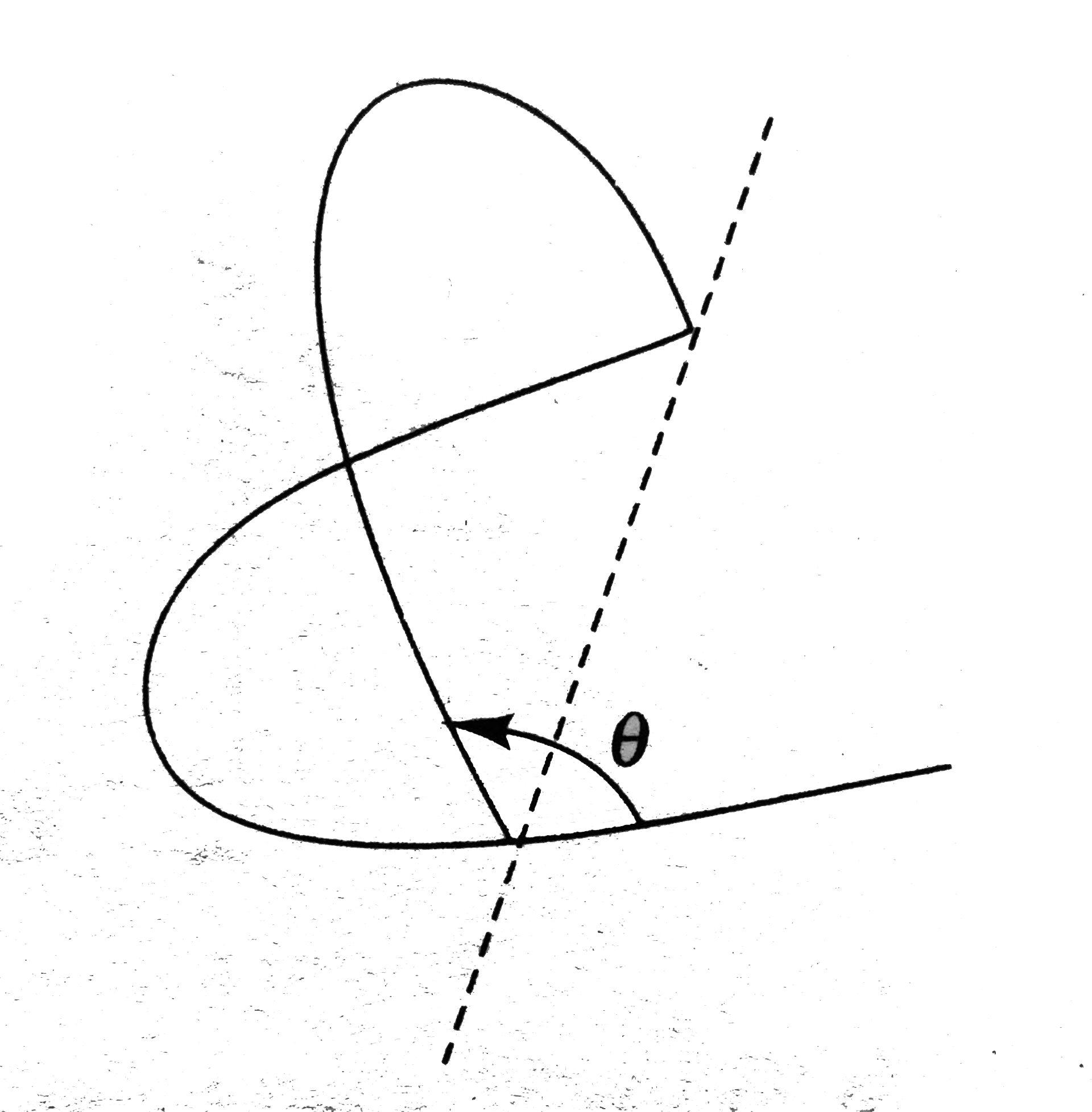A conducting metal circular-wire-loop of radius r is placed perpendicular to a magnetic field which varies with time as , where are constants, at time = 0. If the resistance of the loop is R then the heat generated in the loop after a long time is :
The correct Answer is:B
To solve the problem of calculating the heat generated in a conducting metal circular wire loop placed in a time-varying magnetic field, we can follow these steps:
Step 1: Determine the Magnetic Flux
The magnetic field is given by B(t)=B0e−t/τ. The magnetic flux Φ through the loop is given by:
Φ=B⋅A
where A is the area of the loop. For a circular loop of radius r, the area A is:
A=πr2
Thus, the magnetic flux becomes:
Φ(t)=B0e−t/τ⋅πr2
Step 2: Calculate the Induced EMF
According to Faraday's law of electromagnetic induction, the induced electromotive force (EMF) ϵ is given by:
ϵ=−dΦdt
Calculating the derivative of the magnetic flux:
ϵ=−ddt(B0πr2e−t/τ)=B0πr2⋅1τe−t/τ
Step 3: Calculate the Heat Generated
The heat generated Q in the loop can be calculated using the formula:
Q=∫∞0ϵ2Rdt
Substituting the expression for ϵ:
Q=∫∞0(B0πr2⋅e−t/τ/τ)2Rdt
This simplifies to:
Q=B20π2r4Rτ2∫∞0e−2t/τdt
Step 4: Evaluate the Integral
The integral ∫∞0e−2t/τdt can be evaluated as follows:
∫∞0e−ktdt=1kfor k>0
In our case, k=2τ, so:
∫∞0e−2t/τdt=τ2
Step 5: Substitute Back to Find Q
Substituting this result back into the expression for Q:
Q=B20π2r4Rτ2⋅τ2=B20π2r42Rτ
Final Result
Thus, the heat generated in the loop after a long time is:
Q=B20π2r42Rτ
---
The magnetic field is given by B(t)=B0e−t/τ. The magnetic flux Φ through the loop is given by:
Φ=B⋅A
where A is the area of the loop. For a circular loop of radius r, the area A is:
A=πr2
Thus, the magnetic flux becomes:
Φ(t)=B0e−t/τ⋅πr2
According to Faraday's law of electromagnetic induction, the induced electromotive force (EMF) ϵ is given by:
ϵ=−dΦdt
Calculating the derivative of the magnetic flux:
ϵ=−ddt(B0πr2e−t/τ)=B0πr2⋅1τe−t/τ
The heat generated Q in the loop can be calculated using the formula:
Q=∫∞0ϵ2Rdt
Substituting the expression for ϵ:
Q=∫∞0(B0πr2⋅e−t/τ/τ)2Rdt
This simplifies to:
Q=B20π2r4Rτ2∫∞0e−2t/τdt
The integral ∫∞0e−2t/τdt can be evaluated as follows:
∫∞0e−ktdt=1kfor k>0
In our case, k=2τ, so:
∫∞0e−2t/τdt=τ2
Substituting this result back into the expression for Q:
Q=B20π2r4Rτ2⋅τ2=B20π2r42Rτ
Thus, the heat generated in the loop after a long time is:
Q=B20π2r42Rτ
Topper's Solved these Questions
- ELECTROMAGNETIC INDUCTIONBOOK - NCERT FINGERTPS ENGLISHCHAPTER - ELECTROMAGNETIC INDUCTIONEXERCISE - EXEMPLAR PROBLEMS
3 Videos
- ELECTROMAGNETIC INDUCTIONBOOK - NCERT FINGERTPS ENGLISHCHAPTER - ELECTROMAGNETIC INDUCTIONEXERCISE - ASSERTION AND REASON
15 Videos
- ELECTRIC CHARGES AND FIELDSBOOK - NCERT FINGERTPS ENGLISHCHAPTER - ELECTRIC CHARGES AND FIELDSEXERCISE - Assertion And Reason
15 Videos
- ELECTROMAGNETIC WAVESBOOK - NCERT FINGERTPS ENGLISHCHAPTER - ELECTROMAGNETIC WAVESEXERCISE - Assertion And Reason
15 Videos
Similar Questions
A stationary circular loop of radius a is located in a magnetic field which varies with time from t=0→t=T according to law B=B0t(T−t). If plane of loop is normal to the direction of field and resistance of the loop is R, calculate
amount of heat generated in the loop during this interval.
View SolutionA conducting ring of radius ris placed perpendicularly inside a time varying magnetic field given by B=B0+αl. B0 and a are positive constants. E.m.f. induced in the ring is
View SolutionA stationary circular loop of radius a is located in a magnetic field which varies with time from t = 0 to t = T according to law B=B0t(T−t). If plane of loop is normal to the direction of field and resistance of the loop is R, calculate
magnitude of charge flown through the loop from instant t = 0 to the instant when current reverses its direction.
View SolutionA loop of wire enclosing an area S is placed in a region where the magnetic field is perpendicular to the plane. The magnetic field B varies with time according to the expression B=B0e−at where a is some constant. That is, at t=0. The field is B0 and for t>0, the field decreases exponentially. Find the induced emf in the loop as a function of time.
View SolutionA conducting circular loop of radius a and resistance R is kept on a horizontal plane. A vertical time varying magnetic field B=2t is switched on at time t=0. Then
View SolutionA conducintg circular loop having a redius of 5.0cm, is placed perpendicular to a magnetic field of 0.50 T. It is removed from the field in 0.50 s. Find the average emf produced In the loop during this time.
View SolutionA uniform circular loop of radius a and resistance R palced perpendicular to a uniform magnetic field B. One half of the loop is rotated about the diameter with angular velocity ω as shown in Fig. Then, the current in the loop is

View SolutionA uniform circular loop of radius a and resistance R palced perpendicular to a uniform magnetic field B. One half of the loop is rotated about the diameter with angular velocity ω as shown in Fig. Then, the current in the loop is

View SolutionA conducting circular loop of radiius r carries a constant current i. It is placed in a uniform magnetic field →B0 such that →B0 is perpendicular to the plane of the loop . The magnetic force acting on the loop is
View SolutionA circular wire loop of radius r is placed in a region of uniform magnetic field B such that the plane of the loop makes an angle θ with the direction of B. In which of the following conditions, will no emf be induced in the loop?
View Solution
